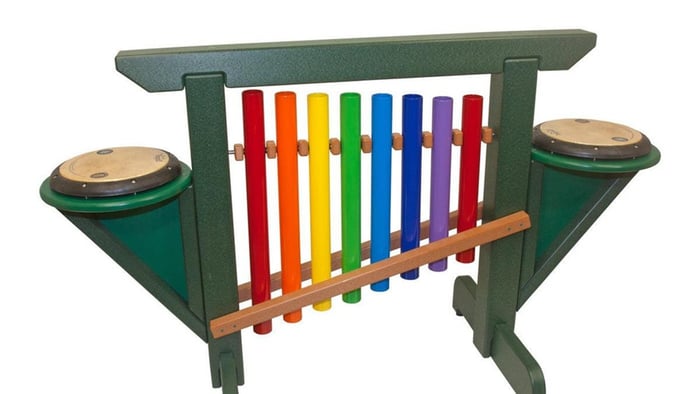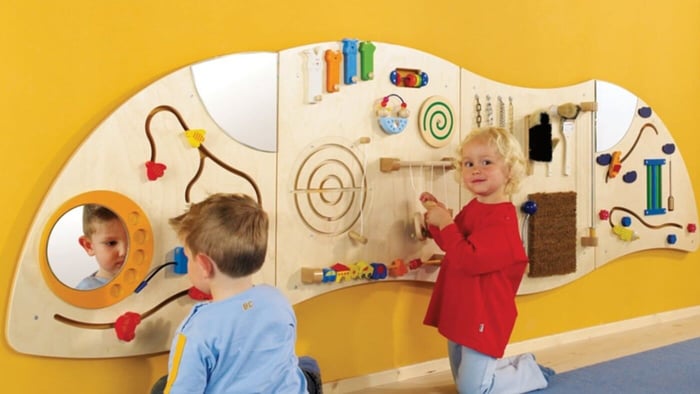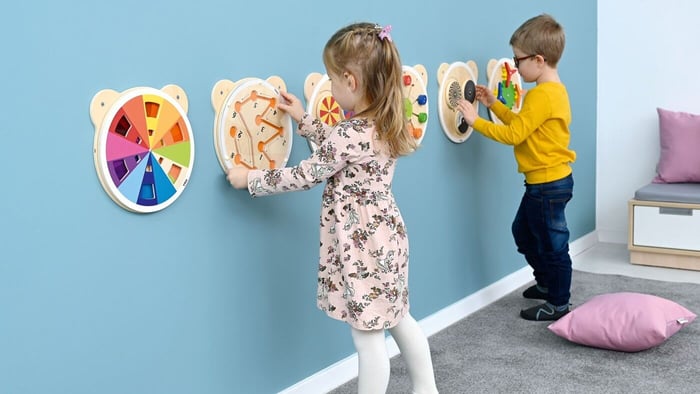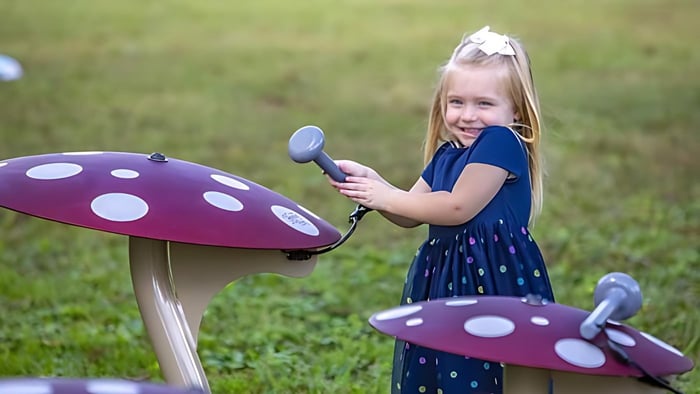
Sensory Friendly Musical Playgrounds: Benefits for Schools
Table of Contents
- Sensory friendly musical playgrounds create inclusive spaces where every child can thrive. By combining sound, touch, and movement, these interactive environments support brain development, emotional regulation, and social growth. With accessible designs that welcome children of all abilities, musical playgrounds encourage joyful play, communication, and learning—making them a valuable asset for schools, daycares, and community spaces.
- Key Takeaways
- Music Beyond Barriers: How Sensory-Friendly Playgrounds Transform Learning
- Inclusive Design Features That Welcome All Children
- Cognitive Benefits: Building Neural Pathways Through Musical Play
- Sensory Regulation: Calming Overstimulated Systems
- Building Social Skills Through Collaborative Music-Making
- Essential Instruments for Sensory-Friendly Playgrounds
- Creating Harmonious Futures Through Musical Play
- FAQs
Sensory friendly musical playgrounds create inclusive spaces where every child can thrive. By combining sound, touch, and movement, these interactive environments support brain development, emotional regulation, and social growth. With accessible designs that welcome children of all abilities, musical playgrounds encourage joyful play, communication, and learning—making them a valuable asset for schools, daycares, and community spaces.
Key Takeaways
- Sensory-friendly musical playgrounds break down barriers for children with physical, sensory, and developmental challenges, enabling participation regardless of ability.
- Musical play simultaneously engages auditory, tactile, and proprioceptive senses, supporting neural development and sensory integration.
- Children experience improved emotional regulation and reduced anxiety through rhythmic and melodic play, especially beneficial for those with sensory processing disorders.
- Accessible design features like drum circles and chime panels positioned at varying heights allow wheelchair users to participate fully alongside peers.
- These environments naturally foster turn-taking, cooperation, and non-verbal communication skills, building community through shared musical experiences.
Music Beyond Barriers: How Sensory-Friendly Playgrounds Transform Learning
The sound of children laughing mingles with the gentle chime of bells and the rhythmic beat of drums. This isn't just any playground - it's a sensory-friendly musical playground where learning happens naturally through joyful play. These specialized environments transform educational settings by creating accessible opportunities for all children to engage in meaningful experiences.
Musical playgrounds from Little People's Cove remove barriers that traditionally separate children with physical, sensory, or developmental challenges from their peers. The instruments provide multi-sensory experiences that accommodate various learning and processing styles, making them inherently inclusive without requiring adaptation.
Unlike conventional playground equipment that often excludes some children, musical instruments invite participation regardless of ability level. The resonant vibrations of a drum can be felt by a child with hearing impairments, while the predictable patterns of musical scales provide comforting structure for children on the autism spectrum. This sensory-rich play engages multiple neural pathways simultaneously, creating powerful learning opportunities.
Inclusive Design Features That Welcome All Children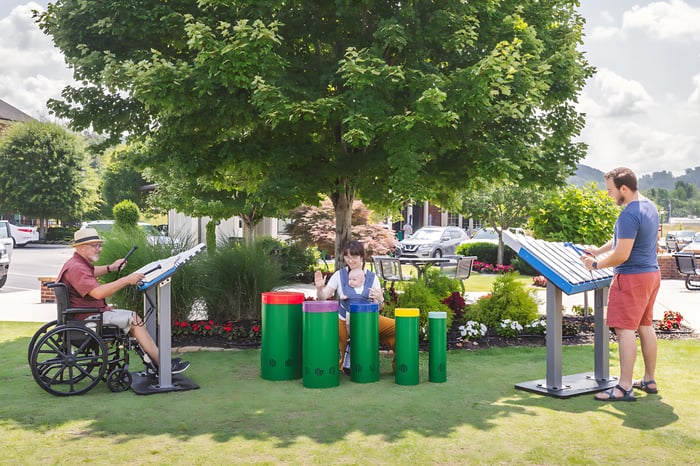
Accessible Instrument Placement for Wheelchair Users
Thoughtfully designed musical playgrounds position instruments at various heights and angles to accommodate children using mobility devices. Features like accessible drum circles with side-approach clearance and angled metallophone panels allow wheelchair users to roll up and participate alongside standing peers, fostering natural inclusion without highlighting differences.
The physical layout of these instruments matters tremendously. When drums, chimes, and tubular bells are arranged in a circular pattern, children naturally face one another, encouraging social interaction while making every instrument equally accessible regardless of mobility level. Suspended instruments provide additional benefits by creating a play experience that offers proprioceptive feedback even without full body movement.
Non-Verbal Communication Through Music
For children who struggle with verbal expression, musical instruments offer a powerful alternative communication channel. The rhythmic beating of a drum or the gentle chiming of bells allows for emotional expression without the pressure of finding the right words. This is particularly valuable for children with language processing disorders, selective mutism, or those on the autism spectrum.
In schools and daycares, staff often observe children who rarely speak suddenly becoming engaged and expressive when given access to musical instruments. The non-verbal nature of music creates a level playing field where language differences and communication challenges fade away, allowing children to express complex emotions through sound rather than words.
Instruments That Accommodate Different Mobility Levels
Beyond wheelchair accessibility, truly inclusive musical playgrounds consider various mobility needs. Instruments with suspended elements allow children with limited upper body strength to create sound with minimal effort. Mallets attached with flexible cords accommodate those with grip challenges or limited coordination.
Some innovative designs feature curved panels that allow children to play while maintaining personal space—particularly beneficial for those with autism who may feel uncomfortable with face-to-face interaction but still want to participate in group activities.
Cognitive Benefits: Building Neural Pathways Through Musical Play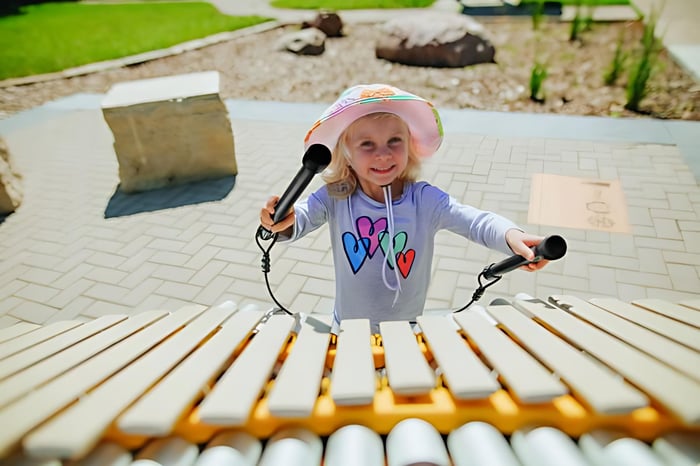
Language Development Through Rhythm and Melody
The connection between music and language development is profound. When children engage with rhythmic patterns, they're actually developing the same neural pathways used in speech processing. Rhythmic play activates brain areas specifically related to language acquisition and emotional processing, creating a foundation for verbal skills.
The cadence of striking a drum or following a melodic sequence on a metallophone mimics the natural patterns of spoken language. Teachers report that regular musical play sessions often correlate with expanded vocabulary and improved articulation, particularly among children with language delays. The rhythmic structure provides scaffolding that supports verbal development naturally and joyfully.
Mathematics Learning Through Musical Scales
Musical instruments naturally introduce mathematical concepts through hands-on experience. When playing sequenced notes on xylophones or chimes, children intuitively grasp patterns, counting, and even fractional relationships. The physical spacing between notes creates a tangible representation of mathematical intervals.
Educators can integrate these instruments into math lessons by using metallophone bars to demonstrate ratios and proportions, showing how doubling or halving length affects pitch, or counting rhythmic patterns as mathematical sequences. These concrete experiences make abstract mathematical concepts accessible even to young children.
Memory and Focus Enhancement
Playing even simple musical sequences requires attention and recall—cognitive skills that transfer to academic learning. Children must remember which notes come next, coordinate their movements, and focus on the task at hand. These exercises in sustained attention have been shown to improve overall concentration abilities.
Sensory Regulation: Calming Overstimulated Systems
Tactile Feedback Benefits
The physical experience of striking an instrument provides immediate tactile feedback that many children—especially those with sensory processing differences—crave. The firm resistance of a drum or the solid vibration of a metallophone bar offers regulating input that helps organize the nervous system.
Instruments like tuned drums, chimes, and marimbas provide varying levels of tactile feedback through their vibrations, which can be felt throughout the arms and even body. This deep pressure input has a calming, organizing effect on children who seek sensory experiences and helps them better regulate their arousal levels.
Proprioceptive Input Through Musical Interaction
The act of playing musical instruments engages the proprioceptive system—our sense of body position and movement. Swinging mallets to strike chimes or reaching across a marimba requires awareness of where our limbs are in space, providing crucial feedback that helps develop motor planning and coordination.
Suspended instruments offer additional proprioceptive benefits, especially for wheelchair users. The slight movement of these instruments requires the player to continuously adjust their muscle actions, enhancing body awareness and coordination without requiring full mobility. This form of engagement promotes development of fine motor control.
Reducing Anxiety and Sensory Overwhelm
Outdoor musical environments offer a unique advantage for children prone to sensory overwhelm. Unlike indoor spaces where sound can reverberate and become overwhelming, outdoor settings allow sound to dissipate naturally. The open-air context also provides visual breathing room and fewer confinement triggers that might cause anxiety. Natural lighting is less harsh than fluorescent indoor lighting, further reducing sensory stress.
Teachers and therapists often note that children who become dysregulated in traditional classroom settings can remain calm and engaged for longer periods in outdoor musical environments. The combination of natural elements, fresh air, and the regulating effects of rhythmic play creates an ideal therapeutic space for sensory processing.
Creating Safe Spaces for Emotional Expression
Musical playgrounds provide natural outlets for emotional expression in an environment free from judgment. Children can communicate joy through rapid, upbeat rhythms on drums, express frustration through controlled forceful strikes on metallophone bars, or find calm through gentle, flowing movements across chimes. These nonverbal expressions give children agency over their emotional landscape.
Many schools incorporate musical playgrounds into their emotional learning curriculum, using them as spaces for children to process complex feelings. For instance, a child struggling with anxiety might find comfort in creating predictable patterns on a marimba, while another working through anger might benefit from the physical release of drumming.
Building Social Skills Through Collaborative Music-Making
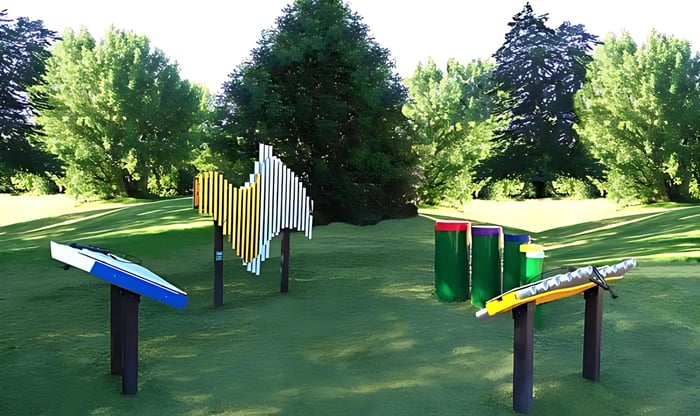
Turn-Taking and Group Participation
Unlike many playground activities that involve waiting for turns, musical playgrounds naturally encourage simultaneous participation. Multiple children can play different instruments together, creating a collaborative soundscape. However, they also learn to take turns with specific instruments and to listen to others' contributions.
This balance of individual expression within a group context creates ideal conditions for developing social awareness. Children learn to adjust their playing to complement others rather than dominate the sonic landscape, a foundational skill for successful social interactions.
Developing Empathy Through Shared Musical Experiences
When children create music together, they must listen to one another and respond appropriately—core skills for empathetic relationships. If one child establishes a rhythm, others might join in complementary ways, demonstrating awareness of and respect for others' contributions.
These musical conversations become powerful metaphors for social interaction, teaching children to both express themselves and make space for others' expressions—lessons that transfer to other social contexts.
Fostering Communication Through Non-Verbal Means
For children who struggle with verbal communication due to developmental differences, language barriers, or anxiety, musical interaction provides an alternative path to social connection. Two children who may not share a common language can still engage in meaningful play through shared rhythms and melodies.
Educators observe that musical playgrounds often become spaces where unexpected friendships form across differences that might otherwise create barriers, such as between children with and without disabilities.
Essential Instruments for Sensory-Friendly Playgrounds
1. Tuned Drums for Strong Tactile Feedback
Tuned drums provide both auditory and profound tactile feedback through vibration. For children with sensory seeking behaviors or those who need additional proprioceptive input, drums offer satisfying resistance and immediate sensory feedback. The varied tones also introduce concepts of pitch and rhythm in an accessible format.
Placement at different heights ensures accessibility for all users, while the intuitive nature of drumming makes it approachable even for children who may feel intimidated by other instruments.
QuaDDDD Play Drum Table
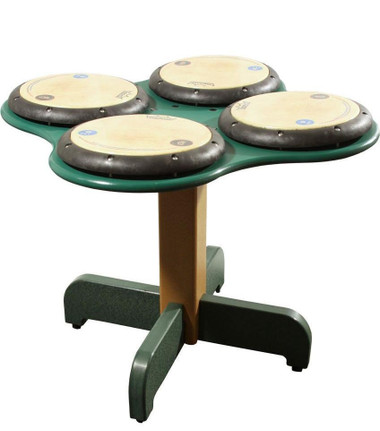
$2,668.00
The QuaDDDD Play Drum Table is perfect for engaging in rhythmic play both inside and outside. It's designed to be easy on the hands and mallets. You can easily...… read more
2. Chimes and Tubular Bells for Gentle Stimulation
For children sensitive to auditory input, chimes and tubular bells provide a gentler introduction to musical play. Their sustained, harmonious tones create a soothing sonic environment that rarely overwhelms even sensitive ears. The visual appeal of these instruments, often designed with attention to aesthetic beauty, adds to the sensory experience.
The sustained resonance of these instruments also encourages patience and listening skills as children wait for one note to fade before playing the next.
Serenade Outdoor Chimes
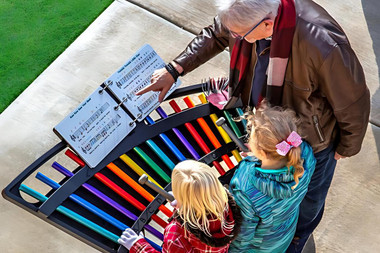
$6,469.88
The Serenade Outdoor Chimes make music fun and approachable for everyone. Featuring color-coded chimes and a matching songbook, this instrument allows players to learn songs...… read more
3. Marimbas and Metallophones for Coordinated Movement
Instruments with multiple bars arranged sequentially help develop motor planning, coordination, and visual tracking. Children must coordinate hand movements across space while visually tracking their progress along the instrument. The reward of a clear melodic sequence provides immediate feedback for successful coordination.
These instruments are particularly valuable for developing executive function skills like planning and sequencing that transfer to academic tasks.
Imbarimba 22 Note Outdoor Marimba
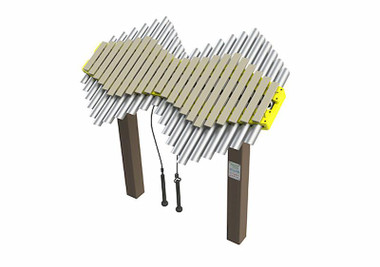
$6,590.70
The Imbarimba blends the rhythmic energy of the African marimba with the melodic charm of the kalimba, creating a one-of-a-kind outdoor musical experience. With its...… read more
4. Suspended Instruments for Proprioceptive Development
Instruments with suspended elements such as hanging chimes or swinging bells provide unique benefits for proprioceptive development. The slight movement requires children to continuously adjust their muscle actions, enhancing body awareness and coordination. This interaction improves motor planning and spatial awareness.
For wheelchair users, these suspended instruments are especially valuable, as the movement creates additional sensory feedback that might otherwise be missed due to mobility limitations, offering an engaging way to experience proprioceptive input.
Cascade Hand Bells

$4,737.49
Crafted from durable anodized aluminum, the Cascade Bells feature seven cascading chimes tuned to a C Major Pentatonic scale. Their bright, resonant tones add both...… read more
5. Curved Designs That Support Comfort During Play
Innovative curved designs allow children who need additional personal space to engage without feeling overwhelmed by proximity to others. These configurations support children with autism or anxiety who might avoid traditional face-to-face interactions but still benefit from group musical play.
The thoughtful arrangement of these instruments creates spaces where children can participate while maintaining their comfort levels, gradually increasing social engagement at their own pace.
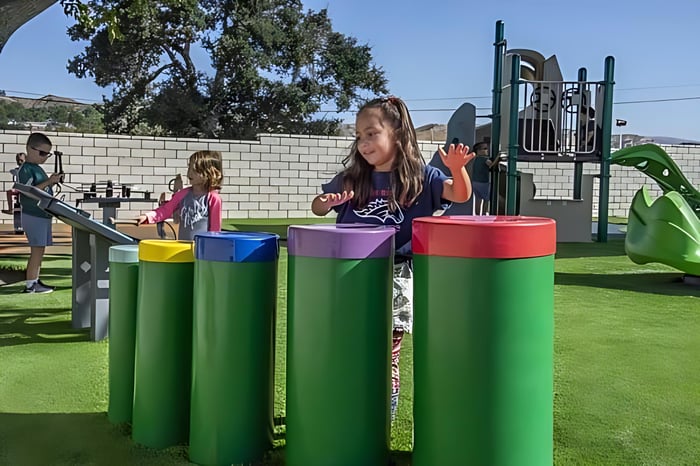
Creating Harmonious Futures Through Musical Play
Sensory-friendly musical playgrounds represent more than just recreational spaces—they are carefully designed environments that support holistic development for all children. By incorporating these spaces into schools and daycares, educators create inclusive communities where differences in ability become irrelevant in the shared joy of making music together.
Little People's Cove specializes in creating transformative musical playground environments that help every child find their voice through the universal language of music, whether through words, movement, or melody.
FAQs
FAQs
What is a sensory-friendly musical playground?
A sensory-friendly musical playground is an inclusive play space equipped with instruments like drums, chimes, and marimbas that engage multiple senses—sound, touch, and movement. These playgrounds are designed for children of all abilities, including those with autism, ADHD, or sensory processing differences. By offering both auditory and tactile feedback, they help kids regulate emotions, develop motor skills, and build social connections through the joy of music
How do musical playgrounds benefit child development?
Musical playgrounds support physical, cognitive, and social growth. Rhythm and melody strengthen brain pathways related to language and memory, while playing instruments enhances fine and gross motor skills. Children also learn cooperation, turn-taking, and empathy through group music-making. For neurodivergent children, musical play can reduce anxiety, improve emotional regulation, and provide a safe outlet for self-expression.
Are sensory-friendly musical playgrounds accessible for children with disabilities?
Yes! Sensory-friendly musical playgrounds are built with accessible design features such as drum circles and chime panels at various heights for wheelchair users, suspended instruments for children with limited mobility, and curved layouts that provide personal space. These inclusive designs ensure that every child can participate fully, regardless of physical or developmental ability, making them ideal for schools, daycares, and community spaces.

